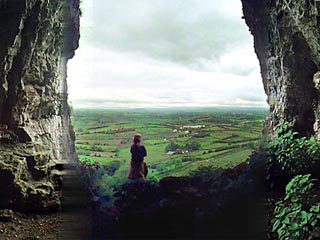
by Philip Butera
We began our day at the Galway market which surrounds the St. Nicholas Church near the center of the city. Every Saturday morning, dozens of merchants set up stands on the sidewalks selling their flowers, produce, arts and crafts, along with many types of souvenirs for tourists and local collectors. We each took off on our own to talk to some of the people selling their goods. It was a perfect opportunity to learn about Irish culture from some extraordinary individuals. .
I spoke to a man who was selling sea shells. He had been diving off his friend's boat during the week, and brought the shells to the market to sell. Raised on a small farm outside of Galway, Thomas worked many different trades to make money. He has been diving for about nine years, and saw the open market in Galway as a great opportunity to do what he loves and get paid for it.
We also interviewed people selling produce from their own farms. Similar to a farmer's market, the Galway marketplace allows local farmers to sell their products directly to the consumer. For those who only have a small garden, the market is a great place to make a little extra money.
After speaking with the venders and walking around the surrounding area, we began our journey to Boyle. Once there, it only took us a few minutes to drive around the city center, but we did stumble onto another outdoor market place. We drove to our B & B which is located next to a 12th century monastery.
Before returning to the city's market place, we walked around the remains of the structure. This particular abbey began as a church in the 12th century, but later construction expanded the original cross-shaped structure to include a gatehouse for the lay brothers (affiliates of the church who haven't taken the final vows to become a monk), a refectory, and a large central square field which was later used as a military parade ground after the monasteries were dissolved and taken over by the Crown.
Its use as a monastery lasted until it was given to Sir John King by Hugh O'Neill in the early 1600's. The abbey, referred to as Boyle Castle at the time, was occupied by Sir John's family till the end of the 19th century. After becoming a military institution, many parts of the structure were destroyed due to cannons and fire damage. However, most of the original structure still stands, along with the additions made throughout its history.
We spent about an hour or so at the site to take photos and virtual reality panoramas before returning to the town market. Again we were given the opportunity to meet with local merchants and shop owners. We all spoke with at least one person from the area, asking them about the city, what they do, and where they have been. Like most of the other cities we have visited, the people were quite friendly, and interested in our journey across Ireland.
Our next challenge was positioned on the side of a steep, 1188' hill. The Keshcorran Caves were built into the stone, 600' above the ground on the side of a difficult hill to climb. These caves, occupied in prehistoric times, were the site of ritual gatherings at seasonal festivals such as Lugnasa until the last century.
The caves also figure in Irish folklore. According to Howard's research: (from the Diary of Gabriel Beranger, 1779)
"The cave is said to communicate with that in the county of Roscommon, twenty-four miles in distance, called the Hellmouth door of Ireland, of which it is told (and believed in both counties) that a woman in the county of Roscommon having an unruly calf could never get him home unless driving him by holding him by the tail; that one day he tried to escape and dragged the woman, against her will into the Hellmouth door; that unable to stop him, she ran after him without quitting her hold, and continued running until next morning.
She came out at Kishcorren, to her own amazement and that of the neighbouring people."
Our goal, however, was to continue to climb up beyond the caves to find a prehistoric passage tomb site, located at the top of the hill. After walking through the caves, we set out in search of the grave. Unfortunately this wasn't an easy task by any means. Just four of us elected to climb, Howard, Rebekah, Chris, and I.
Marching up the steep sides of the hill was quite difficult. With our photo equipment in our backpacks, we started upward. Each time we thought we had reached the top, we discovered another ridge to overcome. The vegetation changed from grass to thick bog brush, which made our mission even more difficult.
After committing ourselves to finding the grave site, we took a deep breathe and continued our quest. We trudged up through rough bracken and soft bog. We had to climb over several rock walls and farmers' fences, each of us getting "tickled" at least once by an electric fence. Each time we thought we were at the top of the hill, another ridge came into sight. After an hour of climbing, we finally had the top of the hill in sight. Reaching up above it, we saw a 15' circular mound of rocks, the passage tomb we had been seeking.
We shouted out for joy, satisfied that we had risen to the challenges of the mountain and reached our goal.
Before returning to join the other two member of our party and leave for dinner in Boyle, we shot photographs and virtual reality panoramas at the top of the monument. We also spend some time examining the geology of the site. Most of the stones of the monument contained numerous fossils, remnants of corals and other marine creatures.
Tonight ends our last full day "on the road." Tomorrow morning, we will drive back to Dublin for our last day of the 1999 Irish Multimedia Safari.
Galway to Boyle
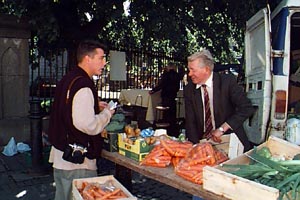
Chris interviews local farmer Michael Stalton about his experiences with the Galway Saturday Market.
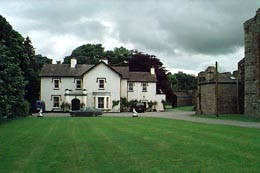
Probably the most elegant B&B that we encountered our on trip, the Abbey House in Boyle is a mansion turned into a welcoming resting place for weary travelers, located directly next to the ruins of Boyle Abbey.
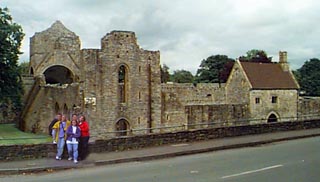
Both Chris and Rebekah made multi-node QuickTime Virtual Reality environments within Boyle Abbey. When completed, these will allow the viewer to explore the different areas of the Abbey by linking together several 360' panoramas.
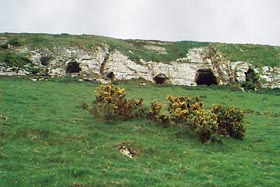
The Keshcoran Caves (also called "The Caves of Kesh") are reached by a steep climb through fields sprinkled with two hazards: sheep dung and stinging nettles. I slipped on one and fell into the other. Ouch!
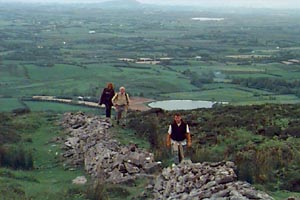
Moving up ahead a bit, I photographed Rebekah, Howard, and Chris as they followed me up the hill searching for the passage tomb.
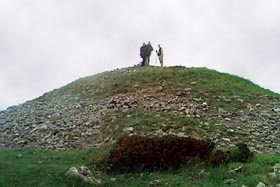
Atop the passage tomb, Chris, Rebekah, and I work on our panoramas. These tombs, from the late Stone Age and the Bronze Age, usually contain a tunnel through the stone mound to the site of the original burial. This one has not been excavated; its passage has not been uncovered.

Apparently what was now an ancient monument from the Bronze Age had once been a coral reef, as its stones were almost all filled with marine fossils.
Back
